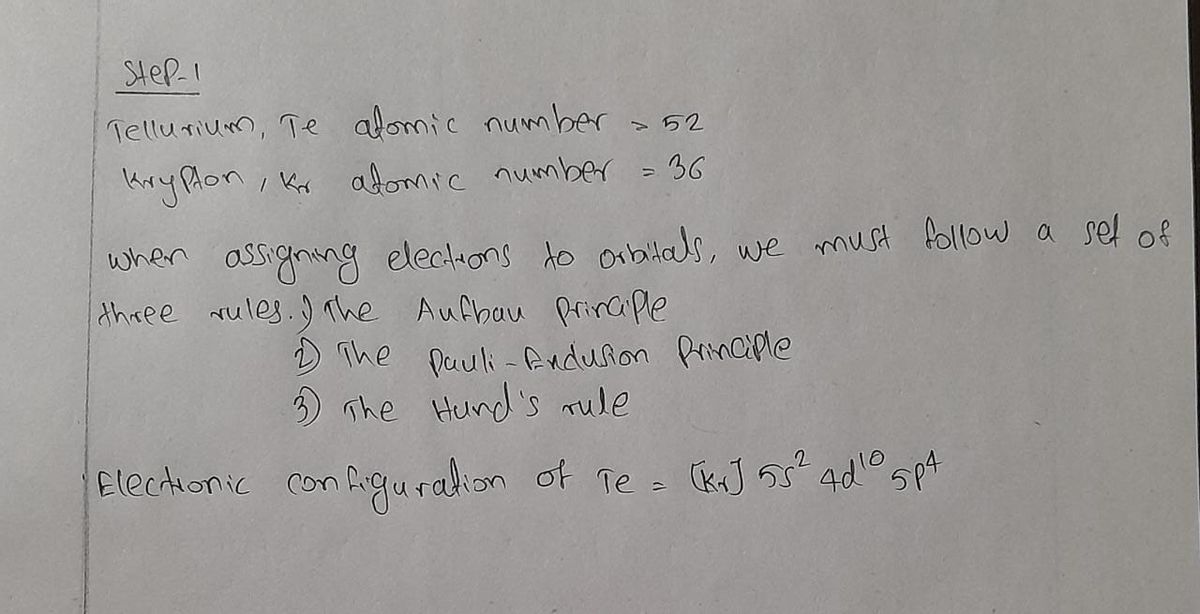General Chemistry 1 Part 2. Electron configurations The picture below shows three answers given by general chemistry students in response to the question: "Draw an Whichblem. these diagrams is the correct one? We will use Plan/Solve/Access strategy to solve this problem. 1212121212 Response A Te [kr] 11 5s 4d Response B Te [Kr] 12 1212121212 5s 4d Response C Te [kr] 1212 1L 5p 1 5s 4d 111 5p ALALALALALALALAL 5p
General Chemistry 1 Part 2. Electron configurations The picture below shows three answers given by general chemistry students in response to the question: "Draw an Whichblem. these diagrams is the correct one? We will use Plan/Solve/Access strategy to solve this problem. 1212121212 Response A Te [kr] 11 5s 4d Response B Te [Kr] 12 1212121212 5s 4d Response C Te [kr] 1212 1L 5p 1 5s 4d 111 5p ALALALALALALALAL 5p
Chemistry
10th Edition
ISBN:9781305957404
Author:Steven S. Zumdahl, Susan A. Zumdahl, Donald J. DeCoste
Publisher:Steven S. Zumdahl, Susan A. Zumdahl, Donald J. DeCoste
Chapter1: Chemical Foundations
Section: Chapter Questions
Problem 1RQ: Define and explain the differences between the following terms. a. law and theory b. theory and...
Related questions
Question
What procedures can we use to solve this problem?
![General Chemistry 1
Part 2. Electron configurations
The picture below shows three answers given by general chemistry students in response to the
these diagrams is the correct one? We will use Plan/Solve/Access strategy to solve this problem.
question: "Draw an orbital box diagram for the ground state of the tellurium atom." Which one of
Response A
Response B
Te [Kr] 11 121212121L
5s 4d
Plan 2:
Te [Kr] 1
55
Response C Te [Kr] 1
55
12 12 12 12 12
4d
1L1L
5p
121 1
5p
12 12 12 12 12 12 12 12
4d
5P
1. Plan your solution:
Often we can solve a problem in a few different ways. There are a few procedures that one
can use to point out the correct electron configuration in a set:
For example,
(a) Plan 1: you can look at each box diagram drawn above to see if you must reject it because
it violates a certain rule. Note that you can do this without considering a particular atom. If
you ended up with the 2 diagrams that don't violate any rule - pick the one with the correct
number of electrons. If you left with just 1 diagram - this must be the correct one.
(b) Now discuss with your group what other procedure can be used to solve this problem.
Write down the plan for this new way to solve the problem.](/v2/_next/image?url=https%3A%2F%2Fcontent.bartleby.com%2Fqna-images%2Fquestion%2F38e21668-df36-4535-9b97-aa4a56ba16f0%2F28b998d2-cad9-45b1-b206-e8abf1efa27c%2Fgx4wu2_processed.jpeg&w=3840&q=75)
Transcribed Image Text:General Chemistry 1
Part 2. Electron configurations
The picture below shows three answers given by general chemistry students in response to the
these diagrams is the correct one? We will use Plan/Solve/Access strategy to solve this problem.
question: "Draw an orbital box diagram for the ground state of the tellurium atom." Which one of
Response A
Response B
Te [Kr] 11 121212121L
5s 4d
Plan 2:
Te [Kr] 1
55
Response C Te [Kr] 1
55
12 12 12 12 12
4d
1L1L
5p
121 1
5p
12 12 12 12 12 12 12 12
4d
5P
1. Plan your solution:
Often we can solve a problem in a few different ways. There are a few procedures that one
can use to point out the correct electron configuration in a set:
For example,
(a) Plan 1: you can look at each box diagram drawn above to see if you must reject it because
it violates a certain rule. Note that you can do this without considering a particular atom. If
you ended up with the 2 diagrams that don't violate any rule - pick the one with the correct
number of electrons. If you left with just 1 diagram - this must be the correct one.
(b) Now discuss with your group what other procedure can be used to solve this problem.
Write down the plan for this new way to solve the problem.
Expert Solution
Step 1

Step by step
Solved in 3 steps with 4 images

Knowledge Booster
Learn more about
Need a deep-dive on the concept behind this application? Look no further. Learn more about this topic, chemistry and related others by exploring similar questions and additional content below.Recommended textbooks for you

Chemistry
Chemistry
ISBN:
9781305957404
Author:
Steven S. Zumdahl, Susan A. Zumdahl, Donald J. DeCoste
Publisher:
Cengage Learning

Chemistry
Chemistry
ISBN:
9781259911156
Author:
Raymond Chang Dr., Jason Overby Professor
Publisher:
McGraw-Hill Education

Principles of Instrumental Analysis
Chemistry
ISBN:
9781305577213
Author:
Douglas A. Skoog, F. James Holler, Stanley R. Crouch
Publisher:
Cengage Learning

Chemistry
Chemistry
ISBN:
9781305957404
Author:
Steven S. Zumdahl, Susan A. Zumdahl, Donald J. DeCoste
Publisher:
Cengage Learning

Chemistry
Chemistry
ISBN:
9781259911156
Author:
Raymond Chang Dr., Jason Overby Professor
Publisher:
McGraw-Hill Education

Principles of Instrumental Analysis
Chemistry
ISBN:
9781305577213
Author:
Douglas A. Skoog, F. James Holler, Stanley R. Crouch
Publisher:
Cengage Learning

Organic Chemistry
Chemistry
ISBN:
9780078021558
Author:
Janice Gorzynski Smith Dr.
Publisher:
McGraw-Hill Education

Chemistry: Principles and Reactions
Chemistry
ISBN:
9781305079373
Author:
William L. Masterton, Cecile N. Hurley
Publisher:
Cengage Learning

Elementary Principles of Chemical Processes, Bind…
Chemistry
ISBN:
9781118431221
Author:
Richard M. Felder, Ronald W. Rousseau, Lisa G. Bullard
Publisher:
WILEY